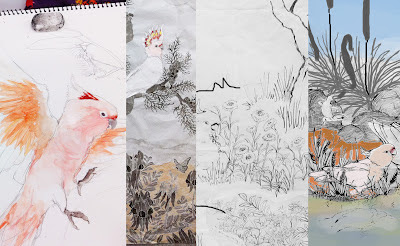After almost 3 months, I finally completed the piece I have been working on.
This time around I wanted to see if I could sucessfully combine the techniques of
katazome and
yuzen-zome (hand-drawn resist) in the one artwork. I was also hoping to depict birds in a lively way; to show them as if jumping off the fabric. I took a lot of inspiration from the world of
nihon-ga Japanese Painting with regards to style, composition, and ideas about empty space. I'm pretty happy with how it has turned out. What do you think?
![]() |
| tentative title : 車冠鸚鵡図 Major Mitchell's Cockatoos |
I'm still deciding what to call this work but I really like the
Kanji for Major Mitchell's Cockatoo (yes! there is a
kanji!) 車冠鸚鵡 (read as Kurumasaka Omu くるまさかオウム) so I think I might work that in there.
The work is comprised of two fabric panels. I'm yet to decide how I will finish it, whether as two hanging fabric panels, as a folding screen (this would be the most expensive option!), or some other solution.
Here are a few details of the work and then I will give you some process photos so you can see how I went about producing this.
1. Sketching and preparing a design
I wrote previously about how much of a challenge this step was for me. It took a long period of sketching, rearranging, painting, cutting up, putting back together etc to get to what you see at left.
2. Cutting a stencil for the
katazome areas
I really like this step; it's sort of relaxing to just sit and cut out the small shapes with a cutter knife for a few solid days. I used the stencil to create the eucalyptus tree area of the design as I felt
katazome is perfect for creating silhouette-like effects.
3. Apply resist paste with the stencil and dye the
katazome areas
I used my stencil to apply the resist paste to the two panels of silk fabric. The paste is dried, hardens, and I used small flat brushes to apply a chemical dye-stuff onto the fabric. The fabric was steamed and washed and you can see what was left.
4. Filling in the gaps with hand-drawn resist paste
Using a resist paste made with rice flour and rice bran, I applied fine lines of resist onto my fabric. I chose to do the cockatoos and flowers in the design using this
yuzen-zome technique because it allows a lot of fine detail and a sense of movement.
5.
Yuzen-zome dyeing stage
Slowly but surely filling in all the areas using multiple brushes and applying dye in gradients. Once complete, the fabric gets steamed again.
6.
Fuse-nori Covering resist paste/7. Background Dyeing
Another layer of resist paste is applied as a mask over the dyed areas to protect them and once that's dry the background colour can be dyed onto the fabric. In this case I used a water sprayer and some large brushes to create a pale yellow sky colour with gradation. After that I used some smaller brushes to fill in the ground and water areas. One final steam and wash and it's finally done!
In other exciting news...I have had two of my textiles made into traditional Japanese
kakejiku (hanging scrolls). They look great! I am yet to show them to my professors. Will do that this week and put up some photos of the finished scrolls. Something to look forward to!








































